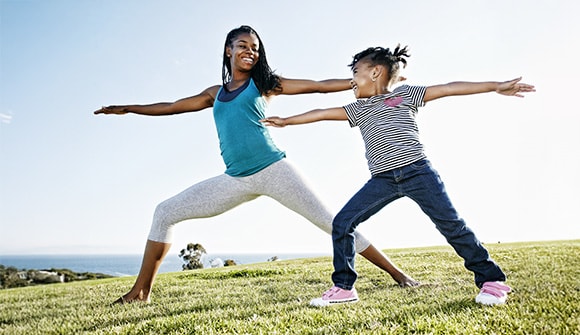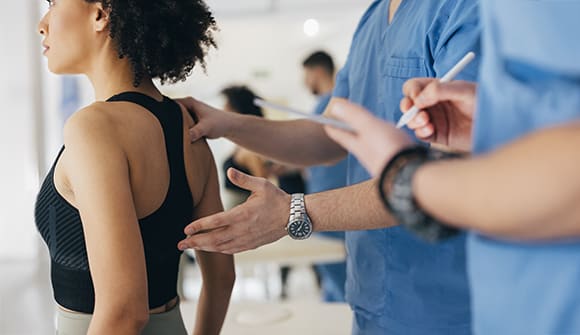Stretch like an Olympian
How movement helps you defeat tight muscles.
Article Date:

OK, so you’re probably not an Olympic-level athlete, but no matter which Tokyo sporting events you follow, chances are the athletes have mastered regimented stretching exercises. And if the Games motivate you to reach new fitness goals, stretching is a strong way to start.
Full-body benefits
Stretching helps your body function better by:
- Increasing joint range and motion
- Improving flexibility
- Boosting blood flow
- Decreasing injury rates
- Enhancing athletic performance
There are two types of stretching: static (remember sitting on the floor in gym class, touching your toes, and holding still for half a minute?) and dynamic (exercises where you extend your muscles without holding the position, like butt kicks and high knees).
Sports medicine experts say dynamic stretching reduces muscle tightness better than traditional static stretching.
“With dynamic stretching, you’re taking your joints through the full range of motion and trying to prepare them for whatever movement you’ll be doing in your sport,” said Jeremy Rush, MD, a pediatric sports medicine surgeon. “Dynamic stretching – sidesteps across the floor, lunges, backward and forward movements, jogging and skipping – improves coordination, power and explosiveness. It primes your brain, so your body is ready to move.”
Static stretching, however, can be beneficial after an exercise or sporting event.
“Your body is warm and there is less chance of injury. Try to tackle every major muscle group including shoulders, glutes and hamstrings,” Dr. Rush said. “You don’t want to stretch cold before a practice. It’s not good for your reaction time and it can lead to weakness and less power and explosiveness. It’s also important not to overstretch to the point of pain. Muscles and tendons contain nerve cells, and pain can lead to injury.”
For static stretching success:
- Hold each stretch 10-30 seconds
- Stretch equally on both sides
- Don’t bounce
- Don’t push through pain
- Breathe
Keeping kids stretching
For young athletes, the types of stretches recommended are usually sport-specific. For soccer, a kid or teen may jog for five minutes and then dribble to get warm, followed by some dynamic stretches like lunges and high knees.
What about kids who don’t play sports? Dr. Rush recommended finding a couple of times a week to warm up – jog, jump rope, cycle – for 5-10 minutes and then do some stretching movements. There’s no best time of day to stretch, according to Dr. Rush, so fitting it into your child’s routine is doable. Just make sure your kids don’t stretch without warming up their muscles, first!
Active adults
Stretching isn't just for kids.
“Joints and muscles tighten in adults, and stretching can optimize the performance of your joints. Stretching before activities combats stiffening and helps with mobility,” said Steven M. Crenshaw, MD, an orthopedic surgeon with Jacksonville Orthopaedic Institute.
Healthy adults should do a cardio warmup for 5-10 minutes before going on a walk or run, and stretch their hips, knees, thighs and calves. It’s important to get blood flowing to the muscles so they are more responsive to the stretching. The hamstring muscle group is the most critical to stretch, Dr. Crenshaw said.
“It’s the largest group of muscles in the body, involved in back and hip movements,” he explained. “About 90% of the population will have back issues at some point. Lack of flexibility in the hamstrings puts pressure on the spine.”
If you’re playing pickleball, you can try stretching your shoulders (they are the most stretch-sensitive) with a cross-arm stretch and then with an arm bent overhead and extending behind your back. Follow that up with some hamstring stretches.
“For swimming or a golf or racquet swing, you want to move your arms into the positions you will be using them in, so they won’t be so tight,” Dr. Crenshaw recommended.
Finding time
There is no standard length of time for stretching sessions. Professional athletes may do an hour and a half of stretching as part of the warmup before practice, and recreational athletes may do 10 minutes of stretching before an activity. But you don’t need to play sports to benefit.
Depending on your daily routine and exercise habits, stretching can be an easy add.
“You don’t have to stretch seven days a week or schedule it at a certain time,” Dr. Crenshaw said. “But some people with arthritis or joint disease in the spine, hip or knee may need to stretch every morning to loosen stiff joints and enhance their mobility just so they can get up and go.”
When not to stretch
“If you’ve had a muscle injury, let the muscle heal first. If it’s a strain or tear, you need to control the swelling and then do gentle stretching to keep it from getting overly tight,” Dr. Crenshaw said. “Also, if you have nerve issues, you don’t want to stretch muscles housing that nerve because it can get more irritated.”
There isn’t one solution for everyone. You can talk to your primary care doctor about recommended next steps.
Daily stretching is one way to optimize health for the whole family. Your primary care physician and your child's pediatrician can provide more guidance for overall wellness. To find the right provider for you and your family, call 904.202.4YOU(4968) or fill out the appointment request form.



